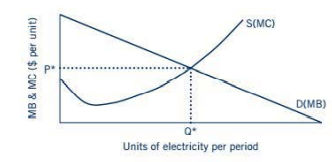Chapter 16: Pollution, The Environment and Global Warming
Pollution is contamination of the ' environment that causes instability, harm, or disruption to ecosystems. Pollution can be naturally occurring or human-induced.
BENEFITS OF POLLUTION:
- Since there has been an increase in the status of technology, the pollution has increased too.
- Technology has made transportation easier with cars, buses, trains etc, but these vehicles have also been a major contribution in increasing the pollution.
The costs of pollution include negative health impacts, climate change, changes in wildlife habitat, environmental degradation, and changes in property values. When your company produces electricity, you pay for coal, hydroelectric dams, nuclear reactors, or wind turbines.
Taking an example of a power plant, to determine the optimal level of electricity to produce, you compare the marginal benefits from electricity generation against the marginal costs of electricity generation.
The level of electricity you produce will determine the amount of pollution you emit from your power plant.
At levels of production below Q*, the marginal benefits gained from producing more electricity exceed the marginal costs incurred, so additional electricity generation increases in your firm's profit.
At production levels above Q*, the marginal costs of additional electricity generation are higher than die marginal benefits, so you would lose profits by producing output above Q*.
Here MC being the Marginal cost and MB being the marginal benefits.

Negative externalities from pollution include negative health impacts and associated health care costs resulting from pollution for those living downstream or downwind from pollution-emitting firms, reductions in property or product value, limits on views because of smog, smoke or exhaust, as well as impacts on climate change.
^^Negative externalities are not limited to pollution-related situations.^^
Command and control methods of pollution reduction involve direct government regulation of pollution through taxes or emissions limits.
The imposition of taxes or fees on polluters is a common method of command-and-control regulation in markets with externalities.
- Taxes and fees increase production costs so chat producers take negative externalities into account when making their production decisions.
- Ideally, a pollution tax would be set just equal to the negative externality.
- A tax of that size would make a producer's private marginal cost of production plus the tax equal to the social marginal cost of production.
Emissions limits place controls or restrictions on specific sources of pollutants.
^^Even when emissions limits are set at the socially optimal level, it is important to meet those limits in the most cost effective way.^^
Common property resources are resources that are collectively owned. Examples of common property resources include public lands and parks, the air we breathe, much of the Earth's oceans, and the wildlife and other resources contained in these common areas.
^^The tragedy of the commons describes how collective ownership of a resource can lead to overuse and destruction of the resource.^^
The tragedy of the commons suggests a method of environmental preservation that does not rely on continual government intervention. By moving away from common property resources and toward private property resources, it is possible to move to the socially optimal levels of environmental use.
- For example, many commercial ocean fisheries use a "race to fish" or "fishing derby" method to manage fish populations. Under this method, legal fishing seasons close once a specific amount of fish is harvested industry-wide.
- The race to fish encourages individual fishers to harvest as many fish as possible as quickly as possible.
- Fishers are rewarded for using larger and larger boats, and they have strong incentives to lobby for larger and larger harvest quotas, both of which result in reduced populations of fish.
- An alternative commercial fishing system allocates an individual transferable quota (ITQ) to harvesters that guarantees the property right to a specified share of the total catch.
- Fishers can then harvest their quota or sell their ITQ to lower cost producers.
- According to research published in Science magazine, the fraction of fisheries that suffers from fish population collapse is half as large in ITQ-managed fisheries as it is in non-ITQ fisheries.
In a cap and trade system of pollution reduction, polluters can buy tradable pollution rights that give the right to emit a specific amount of pollutant. ^^The amount of tradable pollution rights issued is capped at the desired pollution leve^^l.
Carbon offsets are reductions in emissions of carbon dioxide in one place that offset emissions of carbon dioxide made elsewhere.